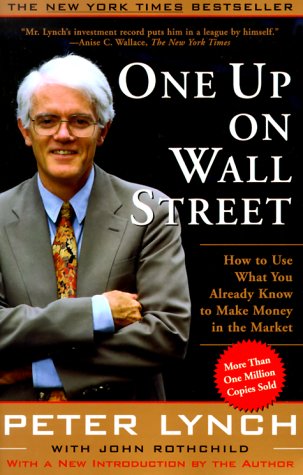 |
||||
|
Book Review
One Up on Wall
Street
|
||||
 |
In our last issue I introduced you to Peter Lynch, the dynamic former portfolio manager for the spectacularly successful Fidelity Magellan Mutual Fund in the United States. And we introduced you to some of Lynch’s ideas and beliefs, most importantly his view that any reasonably intelligent person can beat the average Wall Street expert. In fact, Lynch believes the individual investor actually has an advantage over the Wall Street fund manager because he’s not tied down because of company politics. For example, the average portfolio manager would rather put a fund’s money in a stalwart like Microsoft rather than in a highly profitable upstart in an obscure industry that nobody’s even heard of yet. Why is that? As Lynch explains it, suppose this upstart takes a turn for the worse before it takes off for the stratosphere. The portfolio manager is immediately called on the carpet to explain why he picked this weird stock no one has heard of. A few incidents like that and the portfolio manager decides no more off-beat potential winners for him. He’ll revert to group think believing it’s “safer to pick companies in a crowd.” Not safer for the portfolio but safer for him. The individual investor doesn’t have to explain himself to anyone. He is free to think independently and act on his judgment without fear. The second idea of Lynch’s I mentioned was that the best investment ideas are often sitting in your own backyard. Often investing in the things we observe |
But Lynch goes way beyond those two great ideas in his book. He gives you a step by step guide to picking winning stocks. He discusses the different kinds of stocks, the slow growers, the stalwarts, the turnarounds, the cyclicals, the asset plays and the fast growers.
And he discusses the numbers game. He discusses the importance of earnings, earnings growth, manageable debt, the price to earnings ratio, and so on. And he explains these things in an easy to read, easy to understand way. He doesn’t get all high-falutin’ technical on you.
How easy? Well, consider that his next book featured the exploits of a Grade 7 social studies class who used this book as a guide to putting together a fourteen stock portfolio. As I noted in the last issue, in two years the class’s portfolio made a 70% gain, far surpassing the S&P 500 Index which only returned 26%. Hey, if Grade Sevens can understand and profit from this book, you probably can too!
One of the things I especially like about Lynch is his sense of humor. He pokes fun at Wall Street foibles and comes up with some pretty strange and off-beat ideas on stock picking. One of them is his aversion to technology stocks. He likes the meat and potatoes world and would rather invest in something simple that is easy to understand than something complex and technical.
In a chapter called The Perfect Stock, What a Deal! he discusses the thirteen things he thinks makes for a good stock to invest in. The first is “It sounds dull, or even better, ridiculous.” What a strange notion for finding a good stock. He discovered that a lot of winning stocks have pretty ordinary or even ridiculous names. He says everybody at a party may talk about the latest tech darling, GeneSplice International, for example, when the real winners are Bob Evans Farms or The Pep Boys – Manny, Joe and Jack. These are old examples but one I came across recently that fits this pattern is an outfit called Florida Rock. It makes cement.
Number 2 on his list is “it does something dull”, or even better, number 3 it does something disgusting. He mentions a company that washes greasy auto parts. How gross is that? But the company he mentions was a huge winner for his fund.
Other factors include spinoffs, ignored by institutions and analysts, it’s rumored to be involved with toxic waste or the mafia, there’s something depressing about it, it has a niche in a no-growth industry, people have to keep using the products, it uses technology (note: not companies that make technology but companies that use it effectively), insiders are buying and the company is buying back its own shares.
In the updated 2000 edition, Lynch admits his technophobia caused him to miss out on the computer and Internet boom. He missed Microsoft and Cisco as well as Yahoo and other Internet stocks. But he uses these as examples of stocks the average person can discover in his own back yard. Any one who went and bought a computer in the 90s could have noticed that nearly all of them had a little sticker that said Intel Inside. Wasn’t that a clue that Intel was a great stock? Or that nearly every computer had a Microsoft operating system. Wasn’t that a clue that Microsoft was a great buy? Just as today, every net savvy kid could have noticed that Google was the hottest thing since sliced bread. Everyone uses it. And Google has doubled since it IPOed last year.
Lynch is an enjoyable read.
Contents copyright © Marco den Ouden All Rights reserved






